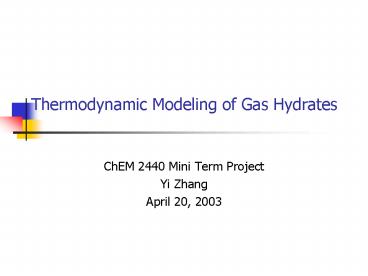Thermodynamic Modeling of Gas Hydrates PowerPoint PPT Presentation
1 / 12
Title: Thermodynamic Modeling of Gas Hydrates
1
Thermodynamic Modeling of Gas Hydrates
- ChEM 2440 Mini Term Project
- Yi Zhang
- April 20, 2003
2
Introduction
- Gas hydrates are crystalline molecular complexes
formed from mixtures of water and low molecular
weight gases. - The water molecules that form
- the lattice are strong hydrogen
- bonded with each other.
- The gas molecules interact with
- the water molecules through van
- der Waals type dispersion forces.
- There is no chemical association
- between gas and water molecules.
- 1
http//www.sns.gov/acns/presentations/chakoumakos.
3
Introduction (Cont.)
- Hydrate formation has long been a problem in
natural gas production, processing and
transportation. - The prediction of equilibrium conditions for
hydrates has received greatly increased interest
in the past decade, because of the discovery of
large hydrate deposits which could be a potential
energy source in the future, and its close
relationship to world environmental protection.
2
4
Thermodynamic model of Hydrate Formation
- The well known van der Waals-Platteeuw (VDW-P)
model was proposed in 1959, which is based on
classical statistical thermodynamics and has the
following assumptions3 - Each cavity can contain at most one gas
molecule. - The interaction between a gas and water molecule
can be described by a pair potential function,
and the cavity can be treated as perfectly
spherical. - The gas molecule can freely rotate within the
cavity. - There is no interaction between the gas molecules
in different cavities, and the gas molecules
interact only with the nearest neighbor water
molecules. - The free energy contribution of the water
molecules is independent of the mode of dissolved
gases (the gas does not distort the hydrate
lattice).
5
The method of Predicting Equilibrium
- At equilibrium,
3
Where,
is the chemical potential of water in the hydrate
phase
is the chemical potential of water in the water
rich or ice phase.
The condition for equilibrium can be rewritten as
Where,
is the chemical potential of an unoccupied
hydrate lattice, used as the reference state.
6
Calculation of
- Assuming an ideal solution relationship for the
water and dissolved gas phase. 3
Where,
experimentally determined reference chemical
potential
is an experimentally determined reference
enthalpy difference between the empty hydrate
lattice and pure water phase at the reference
temperature
is an experimentally determined reference
enthalpy difference
is the mole fraction of water in the water-rich
phase.
7
Calculation of
3
is the ratio of j-type cavities present to the
number of water molecules present in the hydrate
phase
is the gas phase (and hydrate phase) fugacity of
the i type hydrate forming species which can be
calculated by the Peng-Robinson equation of state.
is the Langmuir constant for species i in cavity
j.
is the fraction of j-type cavities, which are
occupied by i-type gas molecules.
8
Calculation of Langmuir Constants
- Langmuir constants for spherical molecules is
determined by integrating the gas-water potential
function over the volume of the cavity. 4
Assuming a Kihara type interaction between the
gas molecule and the nearest water molecules,
and that the cavity is perfectly spherical and
the water molecules which form the cavity are
smeared evenly over the surface of this sphere.
The cell potential obtained is
Where,
9
Modification of the model
- John and Holder determined the contribution of
more distant water molecules by assigning
second and third water shells and developed a
generalized model that could use the Kihara
parameters obtained from virial coefficient data.
5
and
are smooth cell contributions of the first,
second, and third shells, respectively to the
Kihara potential function.
10
Improvement to the model
- The effect of lattice stretching due to gas
molecule size on the reference chemical potential
difference between the empty lattice and water is
calculated by Holder et al.. 6 - A new concept, which included local stability,
linked cavity, basic hydrate, and basic hydrate
component, was proposed in the late 90s. 7 - In 2001, Trout developed a method to extract
potentials from the temperature dependence of
Langmuir constants for clathrate-hydrates by
using an analytical inversion method based on
the standard statistical model of vdW-P. 8 - Sloan proposed a method in 2002, which optimized
the model by direct incorporation of
spectroscopic data. 9
11
References
- 1 G. D. Holder, S.P. Zetts and N. Pradhan,
Phase Behavior in Systems Containing Clathrate
Hydrates A Review, Reviews In Chemical
Engineering, Vol. 5, No. 1-4, 1988. - 2 S.-Y. Lee and G.D.Holder, A Generalized Model
for Calculating Equilibrium States of Gas
Hydrates Part II, Volume 912 of the Annals of
the New York Academy of Sciences, 1999. - 3 van del Waals, J.H. and J. C. Platteeuw,
Clathrate Solutions, Adv. In Chem.Phys., 2, 1-57,
1959. - 4 V. McKoy and O. Sinanoglu, Journal of
Chemical Physics, 38 (No. 12), 2946-2955, 1963. - 5 V. T. John and G. D. Holder, Journal of
Physical Chemistry, 86 (No.4), 455-459, 1982. - 6 Ming-Jing Hwang, G. D. Holder and S. R. Zele,
Lattice Distortion by Guest Molecules in
Gas-Hydrates, Fluid Phase Equilibria, 83,
437-444, 1993.
12
Reference (Cont.)
- 7 Guang-Jin Chen and Tian-Min Guo,
Thermodynamic Modeling of Hydrate Formation Based
on New Concepts, Fluid Phase Equilibria, 122,
43-65, 1996. - 8 Martin Z. Bazant and B. L. Trout, A method to
extract potentials from the temperature
dependence of Langmuir constants for
clathrate-hydrates, Physica A, 300, 139-173,
2001. - 9 A.L. Ballard and E. D. Sloan Jr., The next
generation of hydrate prediction I. Hydrate
standard states and incorporation of
spectroscopy, Fluid Phase Equilibria, 194-197,
371-383, 2002.

